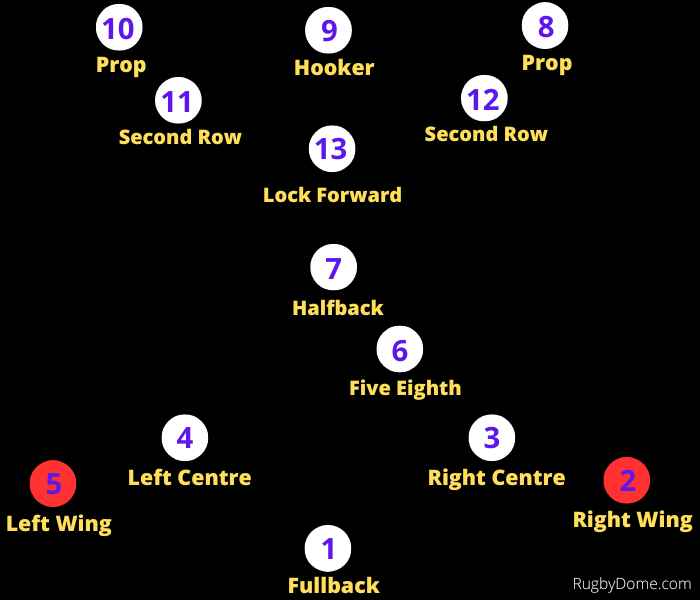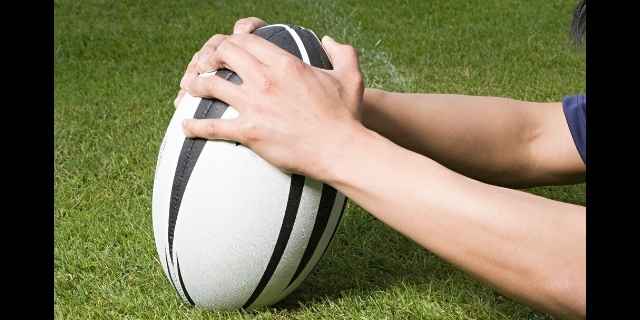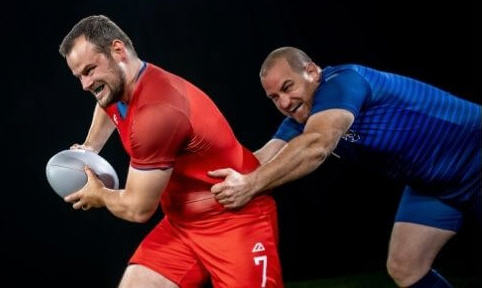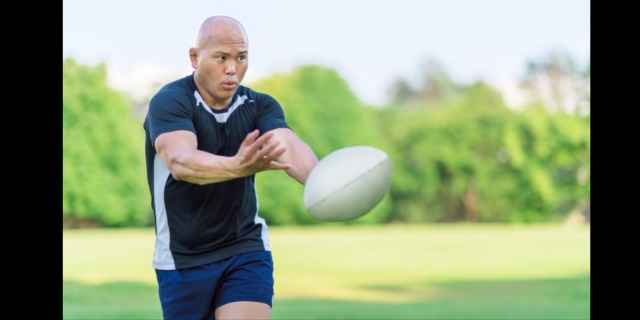The right winger in rugby league traditionally wears the number 2 jersey. The left winger traditionally wears number 5.
Although this is common practice in many competitions and clubs, it’s not mandatory.
This article look sat the crucial role of wingers in attack and defence.
We have a separate article on wingers in rugby union.
Winger Positions
Although scrums aren’t as important in rugby league nowadays, it’s still helpful to show where the two wingers stand in relation to the other players.
This picture shows their position during a scrum.

What Do Wingers Do In Attack?
The primary role of wingers in attack is to get on the end of try scoring opportunities. They are often the players who receive the last pass near the side line.
At this point, wingers pin back their ears and race to the try line.
But a winger can’t just be fast. They must possess other qualities including:
- tactical positioning
- receiving difficult passes
- finishing tries
- kick and chase
- deception and decoy runs
Let’s look at these in turn.
Tactical Positioning In Attack
The two wingers often hug the side lines. This provides width to the attack.
The defending team must stretch their defensive line across the field. As the defenders can’t just bunch up near the attacking ball-carrier, this leaves gaps to exploit.
However, the winger also must know when to come infield to support the attack. If a more central player makes a break and hares up the field, they can leave the larger slower players behind.
As the fastest players on the pitch, the nearest winger should follow the play at speed and be ready to take an offload or a pass.
Receiving Passes
When wingers receive a pass, the ball-carrier is often running at top speed. Executing the perfect pass at speed is a difficult skill that is even harder under match pressure.
That means that wingers have to take imperfect passes. The ball may be slightly ahead or behind their position. The trajectory may be above their shoulders or down near the knees.
It doesn’t matter. Coaches expect a good winger to catch difficult passes and turn them into tries.
Finishing Tries
Wingers must have excellent finishing skills under pressure from desperate defenders.
That includes diving over the try line and keeping control of the ball while a defender is trying to knock it out of their hands.
The other challenge is that the side line is the best defender on the pitch! When the winger is trying to score in the corner, the defenders are trying to push them out of play.

Kick And Chase
The term “kick and chase” refers to the ball-carrier kicking the ball forward and haring after it to regather possession.
To avoid simply giving the ball to a grateful opposition, the usual option is to chip or grubber the ball.
Wingers execute these kicks while accelerating, which is a challenging skill.
Deception And Decoy Runs
A lot of attack is about deceiving defenders into taking the wrong options.
Wingers may join the attacking play and act as if they’re about to receive the ball. When the defenders’ attention is drawn to the winger, the ball-carrier can pass it to a different player.
This is known as a decoy run.
Role Of Wingers In Defence
Every winger is responsible for covering their side of the field. When the attacking team are making hay down one particular side, then that winger’s defence is being seriously questioned.
Wingers must work with their fullback and centres to keep a solid defence line as the attacking play moves across the field.
Aside from positioning, there are other crucial skills:
- Tackling out wide
- Defending kicks
- Kick pressure
Let’s look at these in turn.
Tackling Out Wide

Wingers must be able to make front-on tackles on their opposite winger running down the side line.
But they are also providing cover defence and must rush backward or across the field to make tackles from the side or from behind.
I mentioned that the side line is a team’s best defender. The winger has the advantage of being beside that great defender.
But that also means that they must exploit the advantage by trying to push ball-carriers over the side line and out of play.
That requires a combination of strength, tackling skill, and body positioning.
Defending Kicks
Wingers and fullbacks are responsible for defending kicks. That includes:
- High kicks
- Cross-field kicks
- Low grubbers that skid along the ground behind them
Kick Pressure
This is the opposite situation to being ready to contest a long high kick that is coming down close to the try line.
Sometimes, wingers are tasked with rushing forward to put the opposition kicker under pressure. The closer they can get to the kicker, the pressure they apply with an aim of forcing an error.
Of course, the defending team will be in trouble if all the backs rush forward. This is where communication is key between the wingers and their centres and fullback.
Difference Between Number 2 And Number 5 In Rugby League
I’ve already mentioned that the number 2 is the right wing, and the number 5 is the left wing.
But aside from where they stand on the field, are there other differences in their roles?
Preferred foot
Coaches often decide whether a player is a left or right wing based on their preferred foot for stepping.
Players who prefer to step off their right foot are best suited for the right wing. And vice versa, of course.
Dominant hand

Right-handed players generally find it easier to pass to their left, and vice versa.
So, it makes sense to put right-handed wingers on the right wing and left-handed wingers on the left wing.
If it’s not clear why, let me explain.
Wingers are usually receiving passes on their allocated wing. But when they’re running in support play and are contributing to a passing move, they are moving away from their wing.
Left wingers are moving across to the right and will be more likely required to pass off their left hand to players on their right.
Winger/centre combinations
Right wingers (number 2) form an attacking and defensive partnership with the right centre (the number 3).
Left wingers (number 5) form a partnership with the left centre (number 4).
The best partnerships usually develop over time with players forming an unspoken understanding with each other.
Coaches may want to keep a centre/wing partnership together if they have decided to switch the centres around.